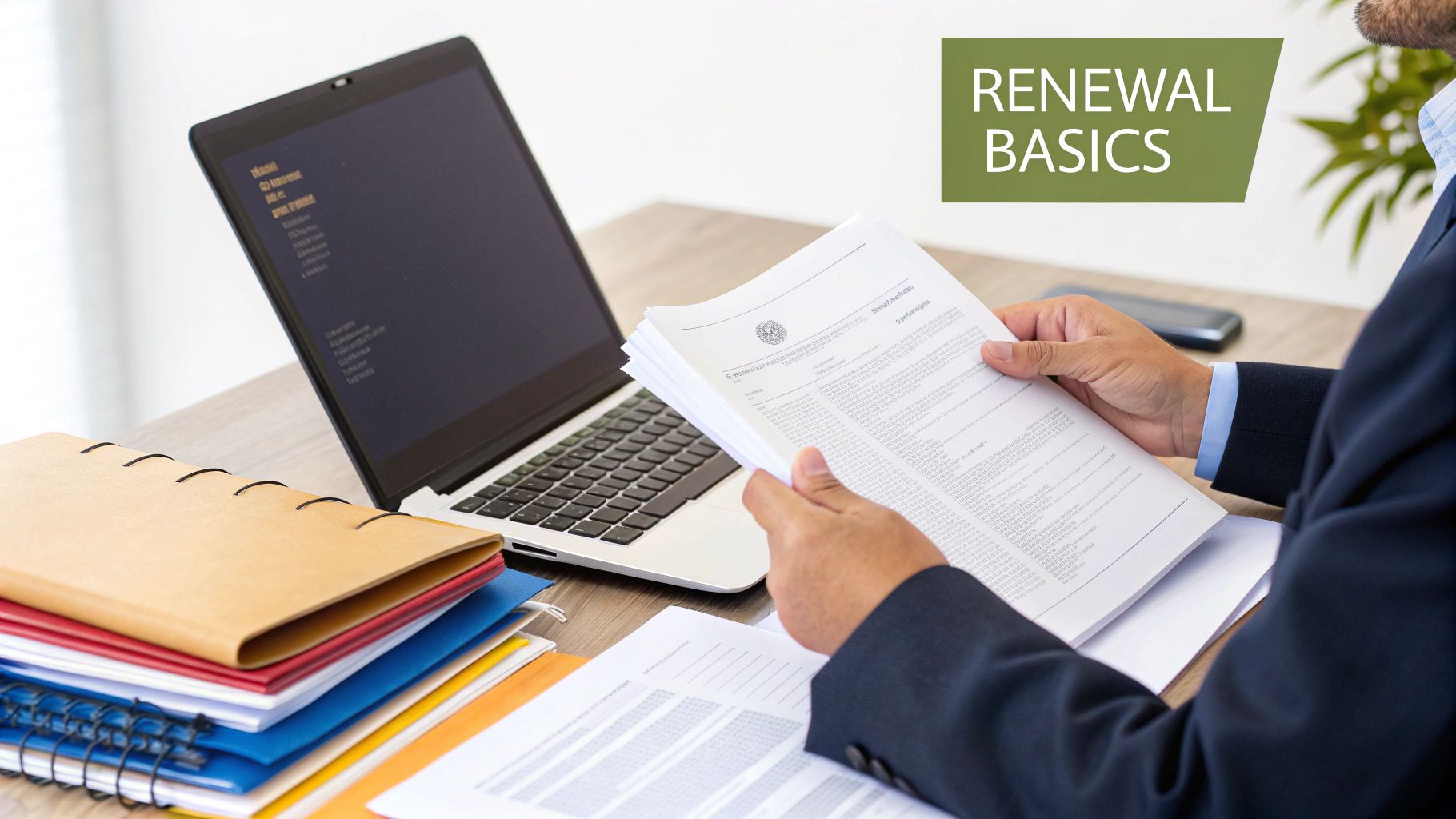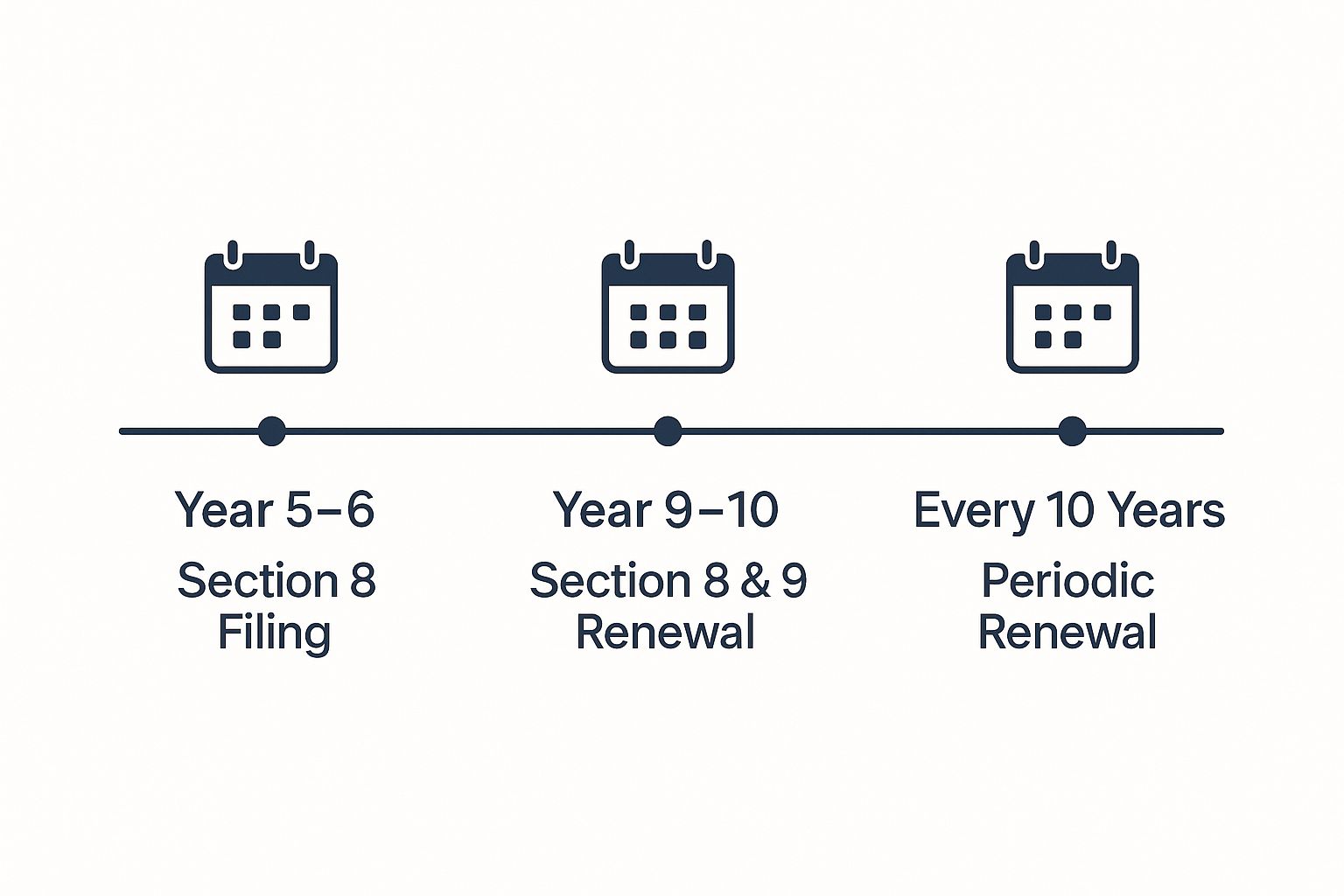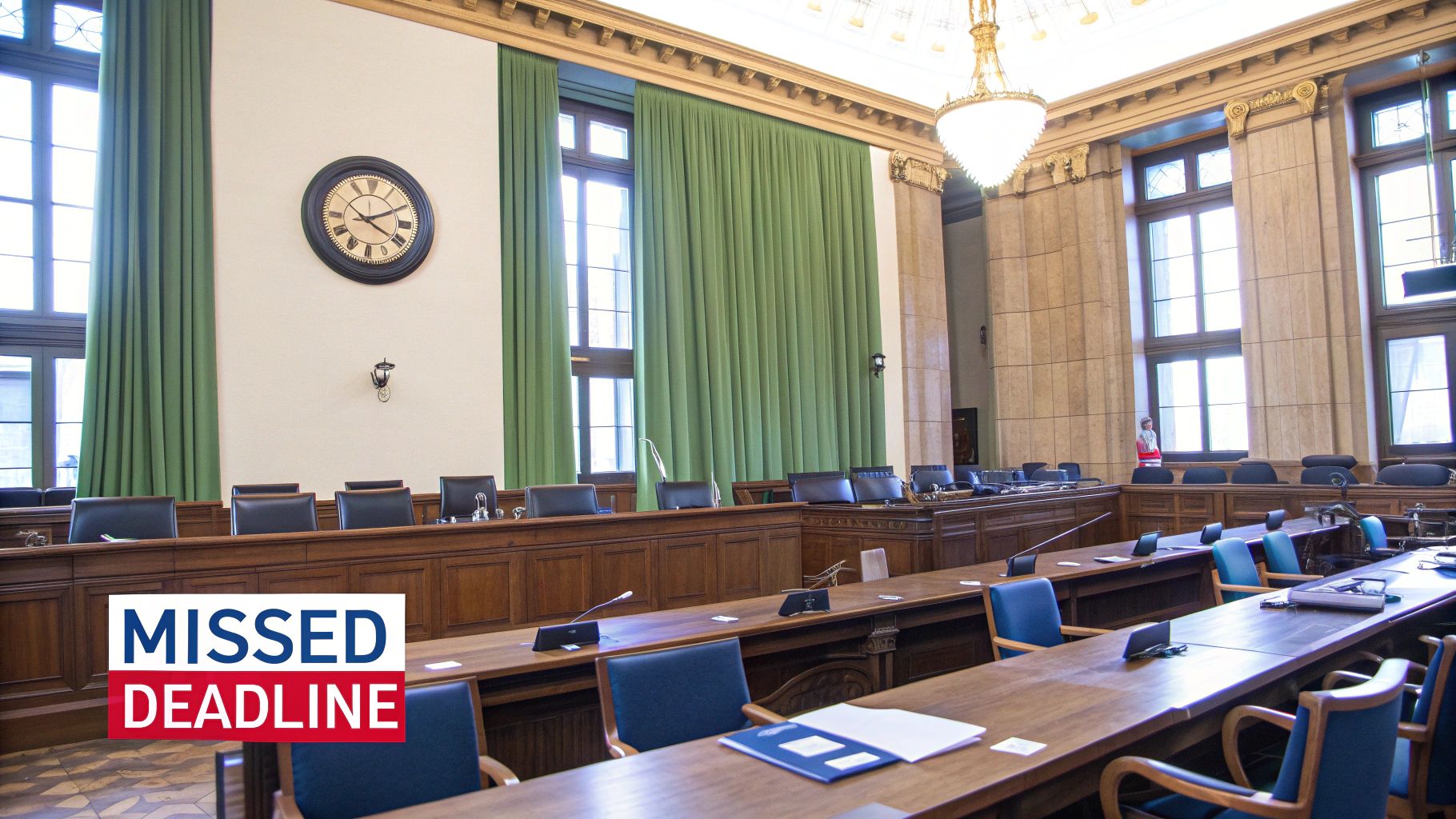The Trademark Renewal Process No One Actually Explains

So, you finally secured your trademark. Congratulations! But don't think you can just file it away and forget about it. Trademarks, unfortunately, expire. Surprise! You need to renew them. This is where many people, even those meticulous about legal matters, stumble. (And seriously, "legal ducks in a row"? Strange phrase.) At Cordero Law, we see this happen all the time. Understanding how to maintain your intellectual property (IP) rights is essential, much like understanding how to retain satisfied customers. It's all about protecting your investments.
Why Renewals Are a Pain (But Necessary)
Dealing with the United States Patent and Trademark Office (USPTO) can be a headache. Navigating their website can be particularly frustrating. However, trademark renewal is the only way to ensure your brand remains yours. It's the difference between owning your brand and watching a competitor swoop in and use your hard-earned name. We're talking about your livelihood. The USPTO has been working to improve its renewal process, making it (supposedly) more efficient. They even have a new dashboard. Check out the latest trademark process efficiency enhancements at the USPTO.
Decoding Section 8 vs. Section 9
This is where things get technical. There are two important declarations: Section 8 and Section 9. They're both declarations, but they serve different purposes. Section 8 is like checking in with the USPTO. You’re saying, “Hey, I’m still using this trademark! Here’s the proof.” Section 9 is the actual renewal, similar to renewing your driver's license. Mess this up, and you could face serious consequences, potentially damaging your brand’s image.
Proof of Use: What the USPTO Actually Wants
The USPTO requires concrete evidence of trademark use. You can't simply state you're using it; you must prove it. This proof includes real-world examples of your trademark in action, such as product packaging, tags, website screenshots, and marketing materials. Anything demonstrating active use in commerce is helpful. And not just any use; it must align with the goods/services you initially registered for. Sometimes, the USPTO's requirements can seem excessive.
Quick Hits on Timing (Because This Post Is Getting Long)
Here's a quick summary of when to file those renewals:
- Years 5-6: First renewal (Section 8) – This initial renewal is vital.
- Years 9-10: Second renewal (Section 8 and 9) – Both declarations are required at this stage.
- Every 10 Years After: Repeat Section 8 and 9. Consider it your trademark's 10-year check-up.
So there you have it – a simplified explanation of trademark renewal. While not exciting, it's essential. Stay tuned for more detailed explanations of each step – because there’s much more to it than meets the eye.
Deadlines That Will Absolutely Wreck Your Trademark Rights

This timeline illustrates the crucial deadlines for maintaining your trademark registration with the USPTO. These deadlines include the Section 8 filing between years five and six, the combined Section 8 & 9 renewal between years nine and ten, and the subsequent renewals every ten years after that. Missing these deadlines can have serious repercussions, making it essential to stay organized.
First Renewal: The 5-6 Year Mark (Why So Early?!)
Between the fifth and sixth anniversaries of your trademark registration, you must file a Section 8 Declaration of Use. This declaration provides proof that you are actively using your trademark in commerce. Think of it as checking in with the USPTO to confirm your trademark's continued use. You're essentially saying, "Look, I'm still using this trademark! Here's the evidence."
Second Renewal: Years 9-10 (Now It Gets Real)
This stage is where things get a little more complex. Between years nine and ten, you need to file both a Section 8 Declaration of Use and a Section 9 Renewal Application. This combined filing officially renews your trademark registration, similar to renewing your driver’s license.
Subsequent Renewals: Every 10 Years (Rinse and Repeat)
After the first decade, you'll need to repeat the combined Section 8 and 9 filings every 10 years. This process becomes a regular part of maintaining your trademark protection. Consider it a necessary check-up for your trademark's long-term health.
To help visualize these important dates, let's look at the USPTO Trademark Renewal Timeline:
This table outlines the key deadlines and grace periods for trademark renewals at different stages.
| Filing Type | Due Date | Grace Period | Consequences of Missing |
|---|---|---|---|
| Section 8 Declaration of Use | Between 5th and 6th anniversary | 6 months | Loss of trademark rights |
| Section 8 & 9 Renewal Application | Between 9th and 10th anniversary | 6 months (Section 9 with late fee) | Loss of trademark rights |
| Subsequent Section 8 & 9 Renewals | Every 10 years after initial renewal | 6 months (Section 9 with late fee) | Loss of trademark rights |
As you can see, keeping track of these dates is critical for maintaining your trademark. While grace periods exist, relying on them can be risky.
Grace Periods (Because Even Lawyers Mess Up)
While there are grace periods – six months for Section 8 and another six months for Section 9 (with a late fee) – it's best not to rely on them. Missing the initial deadline can lead to significant complications.
Real Talk: The Cost of Missing Deadlines
Missing the deadlines altogether means losing your trademark protection. This opens the door for competitors to register the same trademark, potentially jeopardizing your brand identity. Being proactive and meeting deadlines is the best way to protect your brand.
The Money Side: Current USPTO Fees and What You're Paying For

Let's be honest, nobody enjoys discussing fees. But the USPTO isn't operating for free. Their trademark renewal fees can be, shall we say, a bit complex. And the constant changes? Enough to make anyone's head spin. Just when you think you've grasped the current structure, they introduce a new system.
Breaking Down the Costs (It's Not That Simple)
Renewing a trademark isn't a one-time payment. Think of it more as a subscription, requiring regular renewals. At Cordero Law, we understand the frustration. This process isn't exactly transparent, and it's a common pain point for our clients. We'll break down the current fee structure, explain what each fee covers, and, most importantly, explore ways to minimize costs.
The USPTO has been actively adjusting fees. They’re ensuring they have the resources to maintain the trademark system. As of January 18, 2025, the base application fee increased to $350 per class. New surcharges were also introduced, including fees for using free-form identification of goods and services. You can explore these changes further.
What You’re Actually Paying For
It's a valid question: "What am I even paying for?" While some fees might seem excessive, they cover the examination of your renewal application, maintaining the trademark register (a massive database), and the legal protection of your trademark.
It's a cost-effective alternative to losing your trademark entirely. We've witnessed countless small businesses attempting DIY trademarking to save money, only to incur significant expenses correcting errors or, worse, losing their trademark rights.
Some lawyers charge exorbitant fees for what essentially amounts to form-filling. At Cordero, we strive to find a balance between protecting your brand and respecting your budget.
USPTO Trademark Renewal Fee Breakdown
The table below outlines the current fees for different types of trademark renewals and maintenance filings. Note that these fees are subject to change, and it's always best to consult the USPTO website for the most up-to-date information.
| Filing Type | Standard Fee | Deluxe/Premium Fee | Notes |
|---|---|---|---|
| Section 8 Declaration of Use | $325 per class | (Often bundled) | Proof you're still using the mark |
| Section 9 Renewal Application | $325 per class | (Often bundled) | Actual renewal of the registration |
| Combined Section 8 & 9 | $650 per class | (Negotiable, let's chat) | Most common scenario |
"Deluxe/Premium Fee" isn't an official USPTO term. It refers to additional services some firms offer, such as in-depth reviews or expedited filing. At Cordero, we offer transparent pricing and tailor our services to your needs.
Saving Money (Without Losing Your Trademark)
There are strategic ways to manage costs. Bundling your Section 8 and 9 filings is a smart move, often saving money compared to separate filings. Staying organized and avoiding late fees is crucial. We're here to guide you through this process. Trademark law can be complex, but it doesn't have to be a financial burden.
The Actual Step-by-Step Process (That No One Explains Well)
Okay, let's ditch the theory and get practical. I'm going to guide you through the USPTO trademark renewal process, step by step. It's more tedious than it sounds. Many lawyers would simply advise hiring them, but I believe in empowering you. If you want to handle this yourself, I'm here to help. (But seriously, if you mess it up, don't be surprised if I charge extra to fix it. Just sayin'.)
Accessing TEAS (Not Exactly User-Friendly)
First, you need to grapple with the USPTO's Trademark Electronic Application System (TEAS). Let's just say it's not the most intuitive system. Imagine tax software from the 1980s. You'll need to create an account, verify your identity, and navigate the (frankly, clunky) interface. I sometimes wonder if they designed it to be this confusing on purpose.
Gathering Your Documents (Be Prepared)
Next, gather your paperwork. Think of it like preparing for a DMV visit, except instead of your birth certificate, you need proof you’re still using your trademark. This is where those specimens of use come in. And yes, the USPTO is incredibly picky about these. Make sure they're clear, high-quality examples of your trademark in action. A blurry phone photo won’t suffice. I once had a client submit an Instagram story screenshot as proof. Needless to say, that didn't go well.
Navigating the TEAS System (Good Luck)
Once in TEAS, you'll face a series of screens, forms, and strange confirmations that make no sense unless you've done this before. I had a client call me panicking over an error message. Turns out, they clicked the wrong button. It happens. You'll need to complete the correct forms for either a Section 8 Declaration of Use (like checking in, saying "Yep, still using it!") or a Section 9 Renewal Application (the actual renewal). Or both.
Section 8 vs. Section 9: One More Time, For Clarity
The USPTO loves its sections and subsections. Section 8 proves you're still using the mark; Section 9 renews it. Understanding all aspects of trademark renewal can be expensive. When evaluating the costs, remember to consider different customer segments, as discussed in this helpful resource on USPTO fees. Why not just combine them into one form?!
Checking Your Status and Interpreting USPTO Communications (Anxiety City)
After submitting your application, the waiting begins. The USPTO has, thankfully, improved its processing times. You can check your application status online and track its progress. But be warned: their communication style can be anxiety-inducing. You'll receive official-sounding letters filled with legal jargon. I've had perfectly valid renewals initially flagged for minor technicalities, only to be approved later. It's all part of the…fun? Discover more insights about USPTO processing times.
Renewal Disasters I've Seen (And How to Avoid Them)
Alright, let's talk about trademark renewals. And not the fun part. I've seen some truly epic trademark renewal failures, absolute train wrecks. I'm sharing these stories so you don't become a cautionary tale at those legal conferences (which, by the way, are far less exciting than they sound). These mistakes seem obvious in hindsight, but trust me, they happen constantly, even to large companies with big legal teams.
Specimens of Use: Get it Right
I once had a client submit a screenshot of their website as a specimen of use… from three years prior. The USPTO examiners aren't fooled; they check dates. Specimens of use must be current, like a driver's license photo. You wouldn't use one from a decade ago, would you? Use current materials: product photos, recent website screenshots, packaging, marketing materials. You get the picture.
The Wrong Trademark: Double-Check Everything
Another client, a smart and successful business owner, filed a perfect renewal…for the wrong trademark. He had multiple registrations and got them mixed up. It happens. But it's entirely avoidable. Double-check, triple-check everything. Have a second set of eyes review your paperwork. A fresh perspective can catch errors you might miss. (Even I have someone review my work, mainly for typos because spelling isn't my forte, but also for the crucial stuff.)
Logo Changes: Don't Assume
Then there was the business owner who thought a minor logo redesign meant they could abandon their original trademark registration. Big mistake. A significant logo change requires a new registration. But small tweaks? The original mark still holds value. It’s like repainting a car – it’s still the same car underneath. The same applies to your trademark.
Common Renewal Errors (My Biggest Headaches)
- Bad Specimens of Use: We've covered this. Current. High-quality. Relevant. End of story.
- Incorrect Goods and Services: Your trademark protects specific goods and services. If your business has expanded, you might need to amend your registration or file a new one.
- Section 8 vs. Section 9 Confusion: Understandably confusing. Section 8: Proof of use. Section 9: Renewal. Two sides of the same coin, but both are sometimes necessary. See the USPTO website for more information.
- Outdated Contact Info: The USPTO needs to be able to reach you. Ensure your contact information is up-to-date. This seems simple, but it can derail renewals and create a mountain of unnecessary paperwork.
Losing Your Trademark Rights (The Nightmare Scenario)
These aren't just hypothetical issues. I've seen clients lose valuable trademark rights due to these very mistakes. It's not a pleasant experience, and it can be expensive, sometimes impossible, to fix.
I'm not trying to scare you, just save you the trouble and expense. Be organized. Pay attention to detail. And if you’re unsure about anything, consult with a lawyer. It's always better to be safe than sorry.
When DIY Is a Bad Idea (And When It's Totally Fine)

I understand the appeal of DIY. I make my own kombucha (it's surprisingly difficult), handle home repairs, and even attempted to build a bookshelf once (let's not discuss the results). Self-sufficiency is great. However, legal matters, particularly trademark renewals, sometimes require professional expertise.
Knowing When to Call in the Pros
Some trademark renewals are straightforward. Anyone with attention to detail and patience for government websites can manage them. Then there are the complex cases, the ones that resemble attempting a simple plumbing fix only to flood the bathroom. These are the renewals best left to professionals.
Determining which category your trademark falls into depends on several factors. It's not solely about the USPTO's rules and regulations, although those are crucial. It also involves your trademark's value, your resources, and your risk tolerance.
Red Flags That Scream "Lawyer Up!"
Several scenarios indicate that a DIY trademark renewal is too risky:
International Trademarks: This involves navigating different countries, laws, and deadlines, creating a logistical challenge. I once witnessed a client's attempt to handle international renewals independently, and the outcome was unfortunate.
Past USPTO Issues: Previous trademark issues, such as rejections or oppositions, can complicate renewals.
Changes in Use: Significant changes in how you use your trademark since registration necessitate careful handling during renewal, as even small changes can have major implications.
Trademark Conflicts: Disputes or oppositions can be jeopardized by a DIY renewal.
Sometimes, DIY Makes Sense
I'm not suggesting professional help is always necessary. If your trademark is straightforward, its use hasn't changed, and you're comfortable navigating the USPTO website, you might be fine handling the renewal yourself.
A Word of Caution
Even simple renewals can encounter unexpected issues. The USPTO is known for its meticulousness. A minor form error or a slightly blurry specimen of use can lead to rejection. Correcting these errors after the fact can be more costly and time-consuming than hiring an attorney initially.
Carefully assess your situation, weigh the risks and benefits, and make an informed decision. It's your trademark; protect it wisely.
Ready to secure your trademark and navigate the renewal process with confidence? Let Cordero Law guide you. We provide clear communication, understand your challenges, and offer strategic, personalized solutions. Contact us today for a consultation.
